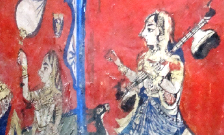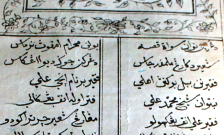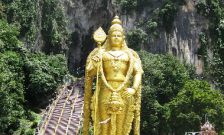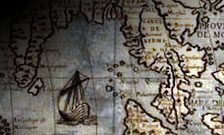 The Awadh Case Study is concerned with imagining pre-colonial histories of music and dance – and forging methodologies to write histories of them – in order to understand the dramatic transformations so meticulously documented in the new cultural histories of late colonial economies of music and dance. For these transformations were not unprecedented and had much longer genealogies, and even today their legacies have been in many cases restricted or partial.
The Awadh Case Study is concerned with imagining pre-colonial histories of music and dance – and forging methodologies to write histories of them – in order to understand the dramatic transformations so meticulously documented in the new cultural histories of late colonial economies of music and dance. For these transformations were not unprecedented and had much longer genealogies, and even today their legacies have been in many cases restricted or partial.
The aim of the Case Study is to think through the question: of what was there to be changed before colonialism really took hold, and how and why it changed over a much longer timeframe than is usually considered, c.1750-1900 and beyond. We overtly consider the fields of music and dance to have been undifferentiated before the late colonial period, and we want to think about how discursive and embodied knowledge systems in this unitary field were transformed in the transition from pre-colonial to colonial regimes through an examination of a wide range of textual and visual sources in multiple languages: Sanskrit, Persian, Hindavi, Hindi, Urdu, and Bengali.
Originally conceived to focus on the transformations at the court of the Nawabs of Lucknow, the geographic remit of the project has extended beyond Hindustan, or the Doab, and Bengal into the Deccan, the court of the Nizams of Hyderabad, and the courts of Kathmandu. Members of the team are analysing a complex web of social and political relationships inflected by geography, language, ethnicity and the ever-present shadow of the colonial state. Our research is based in a rich and diverse multilingual archive: in particular, we have unearthed and are interrogating a huge number of previously un- or under-examined musical treatises spanning the temporal frame and geographical scope of our analysis. Ultimately, the Case Study aims to produce a detailed and revisionist history of north Indian classical music in the period and across lines of genre, class and region.
Members of the team included:
- Katherine Butler Schofield, Principal Investigator and Case Study Leader
- Richard Williams, PhD Student on the Awadh Case Study
- James Kippen, Specialist on tal and drumming, and a Visiting Fellow based at the University of Toronto
- Allyn Miner, Accomplished sitar player and scholar, and a Visiting Fellow based at the University of Pennsylvania
- Margaret Walker, Expert on Indian dance and particularly kathak, and a Visiting Fellow based at Queen’s University, Ontario
 The Malay Case Study is focused on musical transitions in the Malay world c.1511–1918, covering the periods of Portuguese, Dutch and British colonialism in the Malay peninsula and archipelago.
The Malay Case Study is focused on musical transitions in the Malay world c.1511–1918, covering the periods of Portuguese, Dutch and British colonialism in the Malay peninsula and archipelago.
Dr David Irving, an expert on the history of music and Spanish colonialism in early modern Southeast Asia, has been investigating relations between Malay polities and the European port settlements of Melaka, Penang and Singapore, 1511-c.1900. In addition to his work on intercultural connections and colonial discourses on musical syncretism and compatibility, his work has also explored specifically religious forms – the Genevan Psalter, Islamic zabūr – in the colonial Malay world.
Dr Julia Byl's research concerns how the limits of the Malay world can be expanded by attention to cultural relationships with bordering communities, and along the upstream-downstream trade routes so crucial to Malay power. The most natural locus for telling the history of Malay music – and the richest seam of vernacular documentation – is the world of the courts.
 Yet cultural interactions took place on all places along the trade routes, and viewing the experience of trade as formative of an integrated yet diverse Malay world opens space for all sorts of musical discussions: the transmission of Islamic recitation and models of sound from India to Aceh; the aesthetic connections between the musical ensembles of neighbouring areas; and the movement of people, texts, and sounds across colonial boundaries, from Sumatra and the Malay peninsula to Sulawesi and Champa. Julia's projects include an investigation of far-flung symbols of music, magic and power; an investigation of the nobat ensemble and its connections to interior (Batak) musical practice; and a consideration of sound, force, and cultural difference in the 18th-century "Bugis" era of Malay history.
Yet cultural interactions took place on all places along the trade routes, and viewing the experience of trade as formative of an integrated yet diverse Malay world opens space for all sorts of musical discussions: the transmission of Islamic recitation and models of sound from India to Aceh; the aesthetic connections between the musical ensembles of neighbouring areas; and the movement of people, texts, and sounds across colonial boundaries, from Sumatra and the Malay peninsula to Sulawesi and Champa. Julia's projects include an investigation of far-flung symbols of music, magic and power; an investigation of the nobat ensemble and its connections to interior (Batak) musical practice; and a consideration of sound, force, and cultural difference in the 18th-century "Bugis" era of Malay history.
Jenny McCallum is exploring the role of sound, sound-art and music in 19th-century Johore, Singapore and Riau. In the context of Singapore's plural society, her work focuses on the role of sound in neighbourly relations and governance, and explores the Straits Settlements as a different type of space for sound-making than a polity under Malay control. The second strand of her research approaches the vibrant literary scene of neighbouring Riau as a sounding tradition, tracing references to beguiling voices in the texts themselves and assessing the impact of Western influence on the sounding aspect of this tradition.
Finally, Raja Iskander bin Raja Halid is focused on the nobat ensembles of the courts of Kedah and Perak. His research is exploring evolving conceptions of royal power and authority as linked to music and performance in the context of colonial contact and Islamisation.
 The India-Malay Case Study is dedicated to exploring the musical connections between India and the Malay world between c.1800–1950. Dr Jim Sykes’ research has focused on Tamils in the context of migration to the Straits Settlements and Malay world generally, and particularly Singapore, in the period 1830–1957. He has been investigating the transitions of Tamil musics that accompanied the movement of indentured plantation and coolie labourers, and his work elucidates questions of sound and social relations in the Singaporean context, the relations between music and social/ethical life, and the nature of oceans, islands and non-state spaces as sites for the analysis of music and musical life.
The India-Malay Case Study is dedicated to exploring the musical connections between India and the Malay world between c.1800–1950. Dr Jim Sykes’ research has focused on Tamils in the context of migration to the Straits Settlements and Malay world generally, and particularly Singapore, in the period 1830–1957. He has been investigating the transitions of Tamil musics that accompanied the movement of indentured plantation and coolie labourers, and his work elucidates questions of sound and social relations in the Singaporean context, the relations between music and social/ethical life, and the nature of oceans, islands and non-state spaces as sites for the analysis of music and musical life.
Dr David Lunn is focusing in particular on the interactions between European theatrical music making and amateur dramatics, Parsi Theatre, and Malay forms such as Bangsawan, in the soundscapes of the major port cities of the Bay of Bengal – Calcutta, Madras, Penang and Singapore – around the turn of the 20th century. In the relative absence of vernacular chronicles and sources, his work mines the English-language newspaper archive for evidence of the diverse albeit limited cultural cosmopolitanism of these urban melting pots. He is also investigating the Colonial regulation of performers and performances – and particularly the movement of these – in an attempt to supplement our understanding of the opportunities and limits of movement through the spaces of the British Empire.
Additionally, Dr Katherine Butler Schofield is researching the migrations of North Indian musical genres to the Malay peninsula in the early 19th century, and their appropriation into or impact on local musical cultures. The subaltern nature of most of the agents of such transition – sepoys, convicts, nautch girls and faqirs – results in a general elision of their agency from the archive. Nevertheless, traces remain – once again in the English language archive of the colonialists – which throw some light on the transmission of Hindustani music to the Malay world.
Finally, this Case Study is particularly concerned with developing methodologies for analysing complex and diverse inter-regional musical fields such as the Eastern Indian Ocean, and particularly in the era before recorded sound or in contexts absent systematic musical notation or records. This area concern is shared across the Case Studies, and is more fully explored in the section on Connected Histories of Indian Ocean Musics.
 There is a fourth, comparative element to the project, linking the three case studies.
There is a fourth, comparative element to the project, linking the three case studies.
Throughout, we will pay attention to how our findings might contribute to a novel interconnected understanding of eastern Indian Ocean cultures.
We will also develop a synthetic historiographical framework for comparing and connecting the effects of European colonialism on “vertical” and “horizontal” musical transitions within and between India and the Malay peninsula.
Finally, we hope to elucidate both similarities and differences in the ways in which Indian Ocean peoples appropriated and resisted European influences, while engaging in new, transnational modes of living, working, and enjoying music and dance.